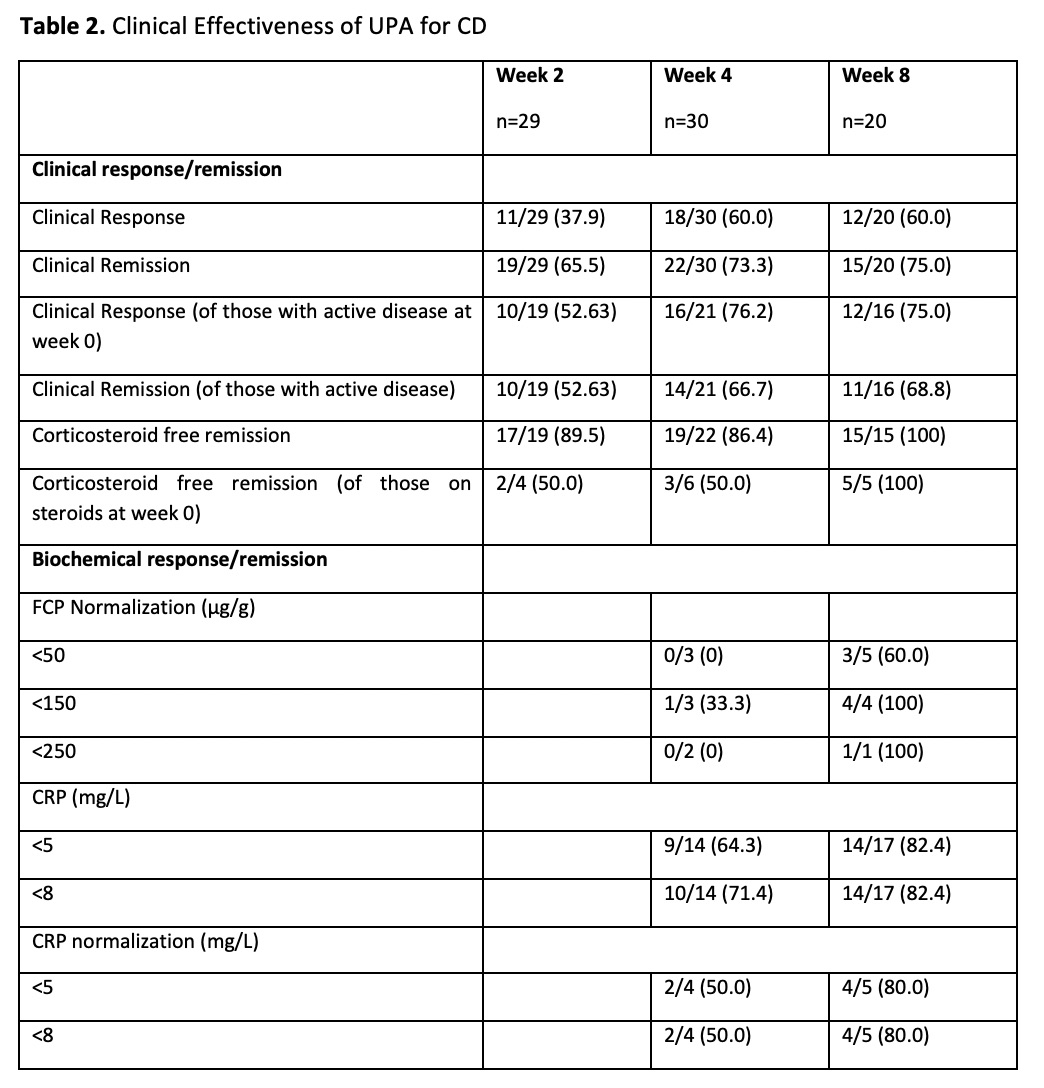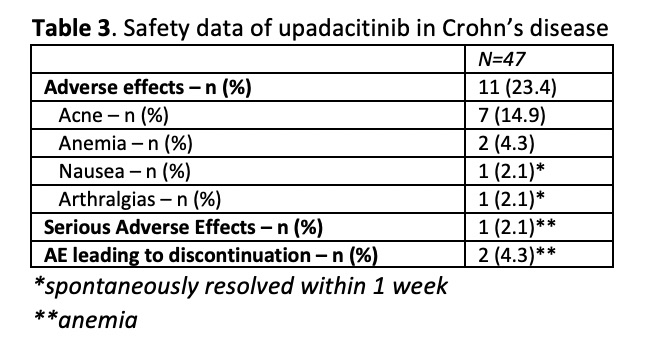P800 Upadacitinib is effective and safe for Crohn’s Disease: prospective real-world experience
Friedberg, S.(1)*;Choi, D.(1);Hunold, T.(1);Choi, N.K.(1);Garcia, N.M.(1);Picker, E.A.(1);Cohen, N.A.(1);Cohen, R.D.(1);Dalal, S.R.(1);Pekow, J.(1);Sakuraba, A.(1);Cleveland, N.K.(1);Rubin, D.T.(1);
(1)University of Chicago, Inflammatory Bowel Disease Center, Chicago, United States;
Background
Upadacitinib (upa) is a novel selective JAK-1 inhibitor that has demonstrated efficacy in the treatment of moderate to severe ulcerative colitis (UC) and Crohn’s disease (CD) and has received regulatory approval for UC. We report our prospective real-world experience with upadacitinib in patients with CD.
Methods
We performed a prospective analysis of clinical outcomes during upa therapy in patients with CD using pre-determined follow-up intervals at weeks 0, 2, 4, and 8 as part of a formalized treatment evaluation protocol at our institution. We used the Harvey Bradshaw Index (HBI), C-reactive protein (CRP) and fecal calprotectin (FCP). Clinically active disease was defined as HBI ≥5. Clinical response was defined as a decrease of ≥ 3 points from baseline HBI. Clinical remission was defined as HBI <5. Corticosteroid free clinical remission (CSFR) was defined as those in clinical remission, not taking any form of systemic corticosteroid at the specific time point. CRP normalization was defined as baseline elevated and then within the normal range for the lab used (Quest Diagnostics (Secaucus, NewJersey) ≤8 mg/L or University of Chicago Medicine ≤5 mg/L). FCP response and remission was assessed at three different cutoffs: less than 250 μg/g, 150 μg/g, and 50μg/g. Adverse events were recorded as treatment-related adverse events (AE) and serious adverse events (SAE).
Results
47 patients with CD received ≥4 weeks of upa (Table 1). 100% had previously received anti-TNF therapy and 93.6% had received ≥2 advanced therapies (biologic, small molecule, calcineurin-inhibitor). At weeks 4 and 8, 16/21 (76.2%) and 12/16 (75.0%) achieved clinical response and 14/21 (66.7%) and 11/16 (68.8%) achieved clinical remission by 8 weeks, respectively (Table 2). Of those who were on steroids at baseline, 100% (5/5) achieved CSFR. Results were seen as early as week 2 with clinical remission rates of 52.6%. Mean HBI decreased from 6.7 (SD 4.6) at week 0 to 3.5 (3.7) at week 8 (Figure 1). Mean FCP decreased by 707.0 (SD 1026.0) μg/g at week 0 to 74.6 (SD 56.2) μg/g at week 8. Of those with FCP >150 μg/g at baseline, 100% (4/4) achieved FCP <150 μg/g by week 8 (Table 2). Mean CRP decreased by 12.8 (SD 19.1) mg/L to 4.9 (SD 8.0) mg/L at week 8. Of those with CRP >5 mg/L at week 0, 80% (4/5) achieved CRP <5 mg/L by week 8 (Table 2). 23.4% of patients had an AE after starting upa (Table 3). The most common of these was acne (14.9%). Two AEs led to discontinuation and there was a single possible SAE (anemia which was also multifactorial from severely active Crohn's ileitis and vitamin B12 deficiency).



Conclusion
In this large, prospective real-world experience in medically-resistant patients with CD, we describe that upadacitinib is rapidly effective and safe.


